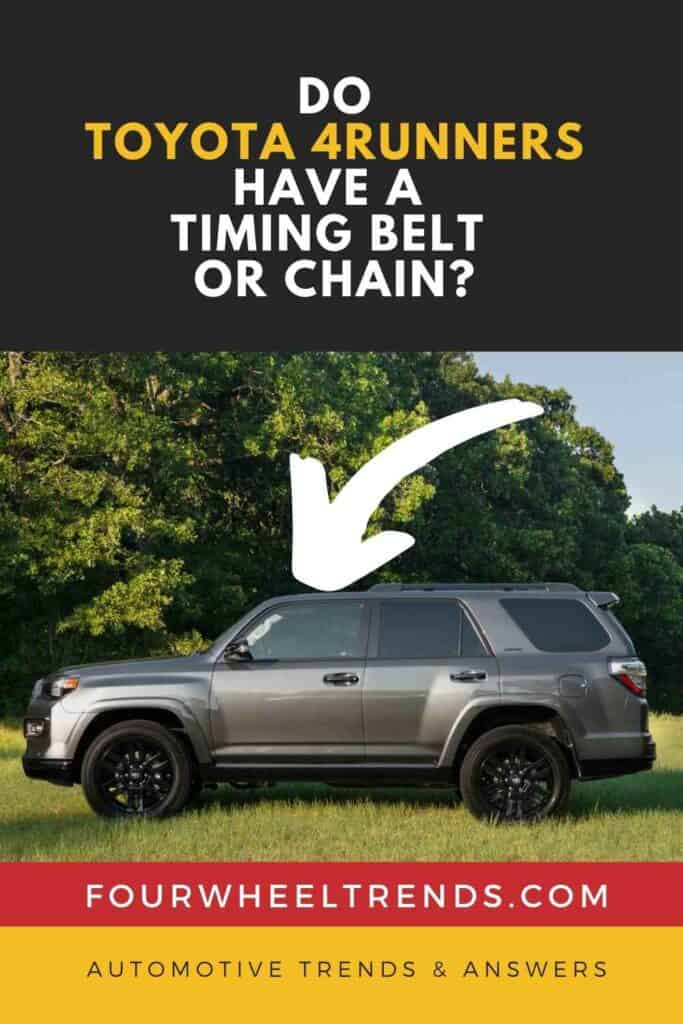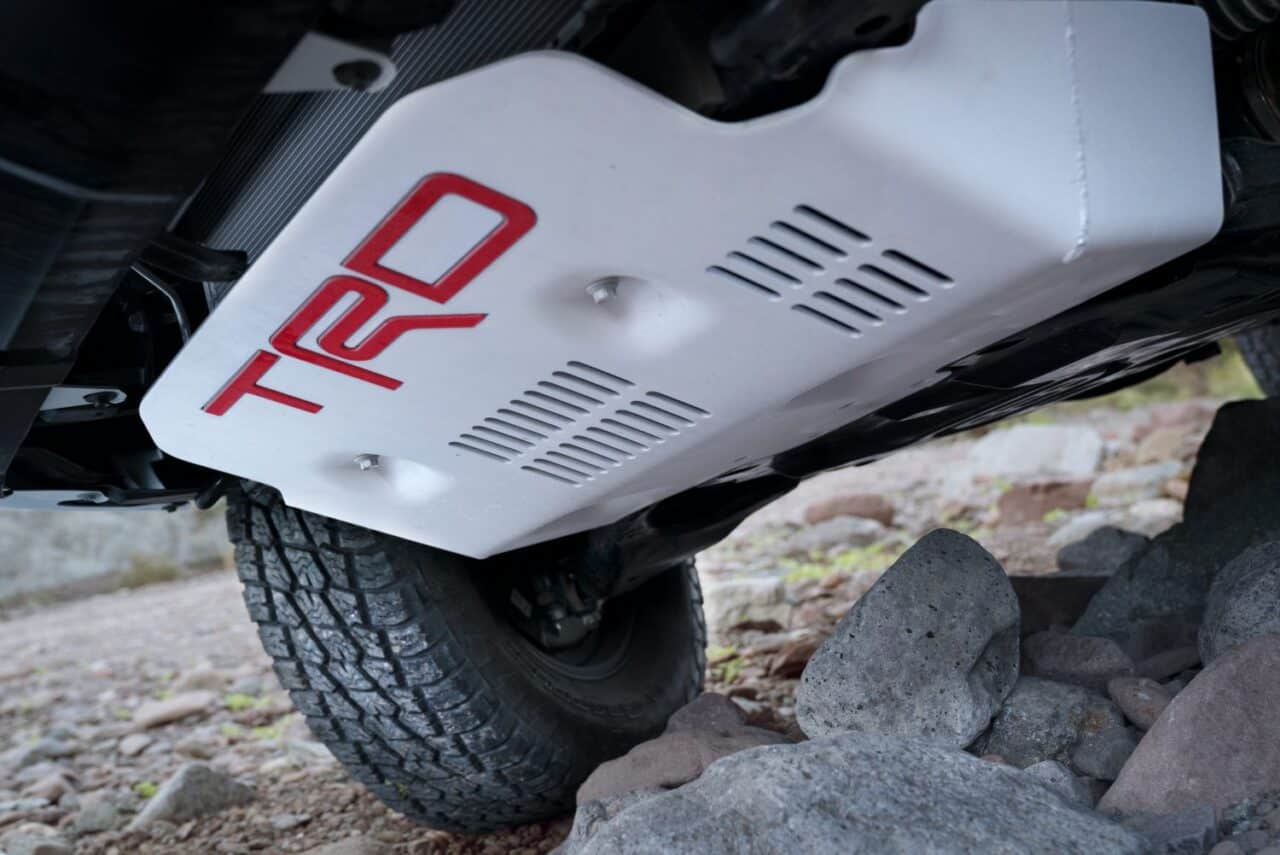Do Toyota 4Runners Have A Timing Belt or Chain?
Different Toyota 4Runners have varying engines. Some engines have timing belts (also known as cambelts), while others have timing chains.
Most 4runner engines are either equipped with timing chains or a timing belts. Timing chains are more durable, and they are usually not replaced throughout the engine lifetime. The timing belts wear out with time and need replacement.

2020 4Runner
All 2020 4Runner models come equipped with a 270 hp 4.0-liter V-6 engine. This engine comes with a chain. They also feature interference engines, which means that when the valve is fully open, it extends to the area in which the piston travels.
2019 4Runner
Like the 2020 4Runner, 2019 comes equipped with the same 4.0-liter V-6 engine. This engine is fitted with a chain.
2018 4Runner
For 2018, the 4Runner comes powered with a 270 hp 4.0-liter V-6. This engine is equipped with a chain.
2017 4Runner
All 2017 Toyota 4Runners have timing chains on their 270 hp 4.0-liter V-6 interference engines.
2016 4Runner
All 2016 Toyota 4Runners have timing chains on their 270 hp 4.0-liter V-6 interference engines.
2015 Toyota 4Runner
All 2016 Toyota 4Runners come powered by a 4.0-liter V-6 hp, equipped with a camchain.
2009-2015 Toyota 4Runners
2009 to 2015 4Runner models are powered by a 270 hp 4.0-liter V-6 engine. This engine model is equipped with a chain.
2003-2009 Toyota 4Runners
2003-2009 4Runner Models are available with two engines. Models powered by 270 hp 4.0-liter V-6 are equipped with timing chains, while those powered by a 268 hp 4.7-liter V-6 have timing belts.
2001-2002 Toyota 4Runners
2001 and 2002 Toyota 4Runners come equipped with 183 hp 3.4-liter V-6 that has a cambelt.
1995-2000 Toyota 4Runners
1995-2000 4Runner models are available with two powertrains. Some models come powered with a 116 hp 2.4-liter four-cylinder engine come with a chain. On the other hand, other models come standard with a 3.0-liter V-6, and they are equipped with a belt.
Timing Chains vs. Timing Belts: Which Ones are the Best?
Most new cars use timing belts instead of timing chains. Though chains are more durable than belts, timing chains make a lot of noise, and they may damage the engine if they breakdown.
Also, the tensioners on engines with timing belts get their tension force from oil pressure. If the pressure is low, the chain will fail. On the other hand, timing belts are quieter and run smoothly.
Their service life is between 60,000 to 100,000 miles. When replacing the belt, the tensioner and the water pump pulley need to be changed too. This additional replacement increases the overall cost.
Timing chains are more durable and can last as long as the engine. They should be lubricated frequently to reduce friction and noise and improve their lifespan.
New Toyota 4Runner models come equipped with a timing chain instead of a cambelt. This is because of their long-lasting durability.
What are The Symptoms of Faulty Timing Chains or Belts?
Faulty timing chains may entirely damage your engine. It is crucial to know the symptoms of defective timing chains to reduce the chances of buying a new engine block. Though timing belts can last a lifetime, they may sometimes wear out.
The following are symptoms of faulty timing chains:
Modern engines come equipped with technology that can detect when the camshaft is not synchronized with the crankshaft. This information is interpreted by the ECU as an error code. The ECU then turns on the check engine light.
Engine Misfiring
A faulty chain or belt would make the engine timing to be off. This will lead to misfiring.
Rough idling
When engine timing belts or chains are faulty or worn out, engines will vibrate when idling. Loose timing chains will make engines produce rattling noises.
These vibrations are produced by the timing chain of the engine. It should be replaced for the proper functioning of the engine.
Metal Chips in Replaced Oil
A worn-out chain may produce metal chips, which are then deposited on the engine oil. It is essential to replace your chain once you start seeing metal chips in old oil.
Low Oil Pressure
Metal chips from worn-out chains may clog the oil pan interfering with the circulation of engine oil, leading to low oil pressure, which would eventually make your engine overheat.
When Should You Replace your Toyota 4Runner’s Cambelt or Chain?
Timing belts are a critical part of your vehicle, but there is no need to replace them regularly. Toyota 4Runner cambelt can last for up to 100,000 miles, while the chain can outlast the engine if properly lubricated and maintained.
Do not wait for symptoms of a worn-out chain or belt. Replace it as soon as it attains manufacturer-recommended lifespan.
Does the timing belt on my 4Runner make noise?
A good cambelt runs smoothly and won’t make any noise. However, when your cambelt starts to wear out, it will begin producing a squeaking or a ticking noise before it fails. If you hear this noise from your engine, you should visit a mechanical technician for a checkup. If you wait for too long, it may cause harmful effects on your engine.
What Happens If I Don’t Have the 4Runner CamBelt Changed?
For Toyota 4runners with non-interference engines, the piston does not travel into any area into which the valve opens. If a cambelt breaks on this engine, the engine will stop running immediately.
On interference engines, the piston travels to the area in which the valve opens. Such engines may experience internal damage if the chain or belt breaks.
The piston may hit an open valve causing unrepairable damage. Replace your cambelt as soon as it attains the manufacturer’s recommended mileage.
Why Is a Cambelt Change Such an Expensive Service in Toyota 4Runners?
The cambelt is generally a costly part of your vehicle. Replacing it also takes a lot of time and labor as it requires disassembling of the engine. Replacing the belt also involves setting the timing and assembling the engine.
This process demands a lot of work and time. This increases the cost of replacement due to labor and time used.
What Else Should Timing Belt Service Include?
Cambelt service should also involve the replacement of other components. These include idler rollers, tensioner, crankshaft seal, camshaft seal, and the water pump.
The water pump is also driven by the cambelt. Replacing the water pump may save you a lot of repair costs in the end.
Can I replace my Toyota 4Runner’s Timing Belt or Chain on My Own?
Unless you are a qualified technician, don’t replace the belt or chain of your vehicle on your own. It involves disassembling your engine, replacing idler pulleys, tensioners, and water pumps.
It requires technical skills. The hardest part is setting the engine timing and assembling it.
Is the chain immune to mechanical failures?
For vehicles with high mileage, a chain problem is common. Like all other moving parts, timing chains are subject to wear and tear. Low engine oil level would also affect the lifespan of your timing chain.
The chain uses engine oil as a lubricant. When the oil level is low, the chain will dry up, and friction will increase as it moves along the gear teeth leading to wear and tear.
The low engine oil level will make the tensioner to fail. The chain will be loose and will vibrate as the engine runs, reducing its lifespan.
More 4Runner Resources
If you enjoyed reading about the Toyota 4Runner, you will surely appreciate my other related articles. These articles delve deeper into specific aspects of the 4Runner such as its off-road capabilities, interior design and technology features.
Additionally, I have compared the 4Runner to other popular SUVs in its class to help you make an informed decision about your next vehicle purchase. Give them a read; I am sure you will find them as interesting and informative as the first article.
Wrapping Up
Regardless of which 4Runner model year you have, you will experience very minimal belt or chain problems. Always check your belt and chains and lubricate to improve the lifespan of the chain.




